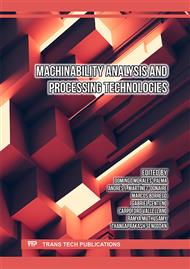p.3
p.13
p.25
p.35
p.45
p.57
p.67
p.77
Surface Characterisation and Comparison of Polymeric Additive Manufacturing Features for an XCT Test Object
Abstract:
Additive manufacturing (AM) has experimented a huge development in recent years, improving the physical properties of parts produced by these technologies to the level of being capable of fabricating end-use functional products. High performance metals are widely used and studied; however, the reduction in material costs of polymers and their acceptable properties makes them suitable for common AM purposes. The intrinsic surface roughness of AM, as a consequence of the layer-by-layer technology, remains a challenge and its characterisation is necessary for quality control. X-Ray computed tomography (XCT), as a newly adapted evaluation technology for industrial applications, sets an opportunity for the dimensional measurement of AM parts, due to its capability of characterising the complex geometries that is possible to create with this manufacturing technologies. In this paper, a first approach to a surface characterisation of polymeric AM parts is presented. Several individual objects have been designed and manufactured using various polymeric AM technologies with different manufacturing principles (FDM, Polyjet, SLS) to build ramps with a range of surface roughness created by two main parameters (angle of inclination and layer thickness). Measurements have been carried out by an optical device (focal variation microscope, FVM), and a comparison with theoretical roughness values calculated following predictive models has been made, with the objective of analysing the behaviour of each surface. Results show that the influence of the angle of inclination is higher than the influence of layer thickness; post-processing, also, affects to the trueness of the real roughness comparing to the predicted one obtaining more unpredictable results.
Info:
Periodical:
Pages:
35-44
Citation:
Online since:
October 2023
Price:
Сopyright:
© 2023 Trans Tech Publications Ltd. All Rights Reserved
Share:
Citation:



